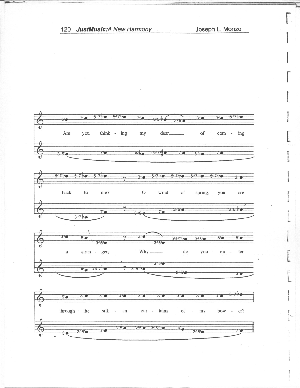Harry Partch: The Intruder
An Examination of
Partch's Li-Po Lyric "The Intruder"
webpage and music examples © 2002 by Joe Monzo
Partch's Li-Po Lyric "The Intruder"
webpage and music examples © 2002 by Joe Monzo
(use of Partch's recording of 'The Intruder' courtesy of The Harry Partch Foundation, 2002)

Harry Partch in 1932
holding his Adapted Viola and model of the Ptolemy keyboard
Harry Partch's earliest surviving microtonal compositions are his Seventeen Lyrics of Li Po, settings for intoning voice and Adapted Viola of poems from Shigeyoshi Obata's 1928 English translation The Works of Li Po, the Chinese Poet. They were written between 1930 and 1933 in places as widely separated as New Orleans, Gloucester (Massachusetts), and San Francisco.
The poet's name is now usually spelled Li-Bai; he used to be known as Li Po or Li T'ai Po. He lived during the Tang Dynasty and wrote this poem around 740 AD. Below is a map of China during the T'ang Dynasty:
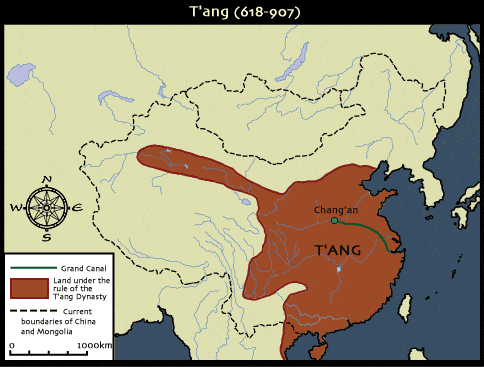
Below is the poem as it appears in the original Chinese, and next to it the English translation of each character. The Chinese characters, translation, and notes are from The Heart of Chinese Poetry: China's Greatest Poems Newly Translated, by Greg Whincup (Anchor Press/Doubleday, New York, 1987). Whincup's translation of the original title is "Spring Longing".
In the third column is the translation by Shigeyoshi Obata which was used by Partch. The title and translation by Obata differ in several aspects from Whincup's. Note that the version by Obata transposes the 3rd and 4th verses, and Partch retained this order in his setting.

by Li-Bai

|
Yen1 grasses like bright green threads |
The grass of Yen
is growing green and long |

|
Chin 2 mulberry trees hang down green branches |
While in Chin
the leafy mulberry branches hang low. |

|
on Lord's 3 cherish return days |
Are you thinking, my dear,
of coming back to me? |

|
these servant's 4 cut guts 5 times |
Even now,
while my longing heart is breaking, |

|
spring wind 6 not mutual know |
O wind of spring,
you are a stranger; |

|
what affair enter gauze silk curtain? |
Why do you enter
through the silken curtains of my bower? |
|
1 Yen is the area around modern-day Peking. It was in the far north-east of Tang China, and soldiers were stationed there to guard the border. 2 Chin is the area around the Tang capital, Chang-an (now Sian), at the western edge of the North China Plain. 3 "Lord" was how friends addressed each other, and how a wife addressed her husband. 4 "Servant" was how wives referred to themselves when speaking to their husbands. 5 "Cut guts" is like our "heart-rending" or "heart-broken" 6 "Spring wind" is a conventional symbol of sexual feelings. |
Partch's setting is for Intoning Voice and Adapted Viola. Both parts are tuned in just intonation. The rhythm is free, the viola part following the rhythm of the voice part, which may be viewed as a form of stylized speech. Partch's own score simply notated the pitches of both parts as numerical ratios. Joe Monzo transcribed it into a 12-EDO-based version of HEWM notation, as published in his book JustMusic: A New Harmony. The HEWM notation is supplemented by the prime-factors and their exponents, as described in Monzo's article JustMusic Prime-Factor Notation. The 2-page transcription of Partch's score is shown below (click on the small graphic for the full-size version. Note that Monzo now prefers to use a version of HEWM which has additional accidentals and is based on 72-EDO.)
Below is a Monzo lattice diagram of the pitches used in "The Intruder". (This is the non-inverted form of Monzo lattice, as described on his Harmonic Lattice Diagrams page; compare this diagram with the 7-limit Tonality Diamond shown there.)
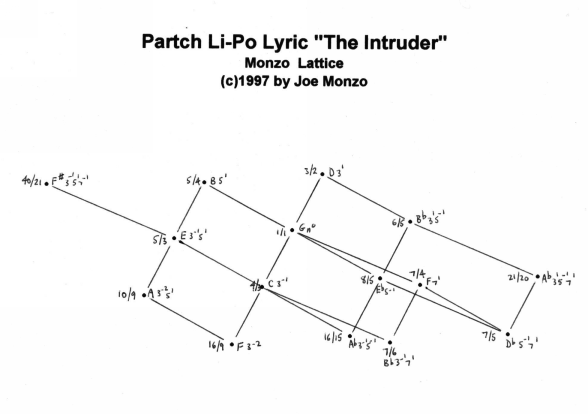
Below are two lattices of Partch's Intruder tuning, produced by Tonescape, the first using rectangular geometry (similar to the Monzo lattice above) and the second using triangular geometry.
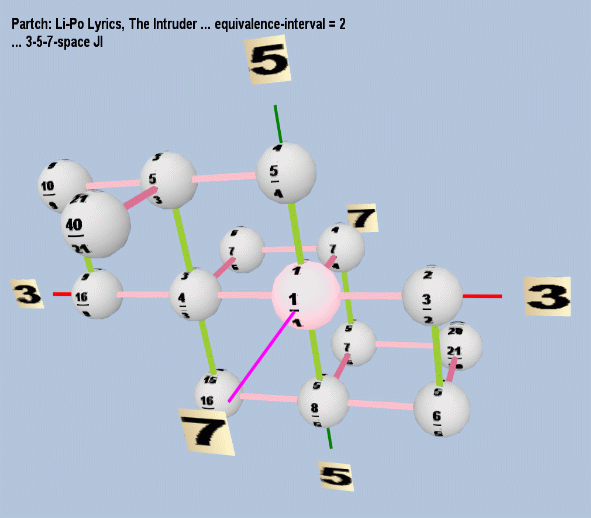
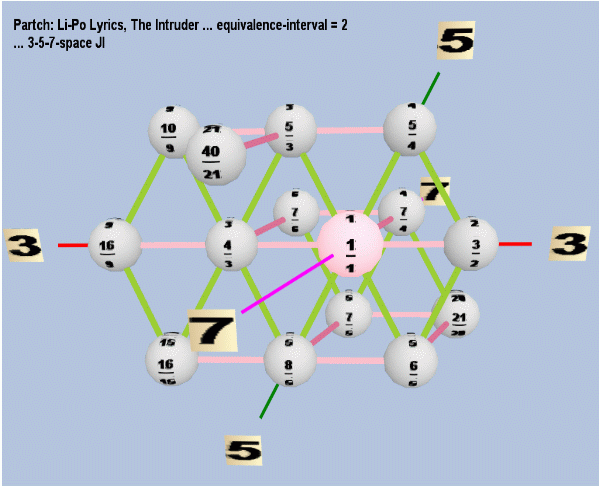
See also:
-
Bob Gilmore's excellent analysis of this piece in:
"On Harry Partch's Seventeen Lyrics by Li-Po" in
Perspectives of New Music,
volume 30 number 2, Summer 1992, p 138-165. - Ted Mook's page about the Li-Po Lyrics. Note that Mook made a transcription of Partch's Li Po Lyrics into the 72-EDO notation devised by Ezra Sims (an example of which from Joe Maneri's book is here) -- there is a description of this near the bottom of Mook's page. There is thus quite a bit of similarity between this and the HEWM notation I use today, the only differences being those between the symbols used by myself and Sims, and the presence of the prime-factors and their exponents in HEWM. (Unfortunately, the transcription I give on this page is a few years old and does not use the 72-EDO accidentals.)
- Other composers who have set Li Po's poems in Obata's translation are Arthur Bliss (The Ballads of the Four Seasons, 1923) and Constant Lambert (Four Poems by Li-Po).
- Four of Li-Po's poems, in German translation by Hans Begthe after the French translation by Judith Gautier and D'Hervey-Saint-Denys, were used by my favorite composer Mahler in what many consider to be his greatest piece, Das Lied von der Erde. Note that this was the one piece by Mahler which Partch explicitly singled out for praise in his book Genesis of a Music.
- A selection of lyrics set to music by Partch, including all 17 by Li-Po, is at Lyrical Partch, which is part of Corporeal Meadows, the official internet home of Harry Partch.


